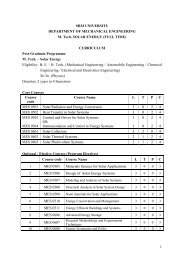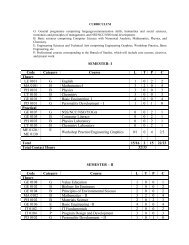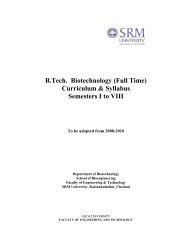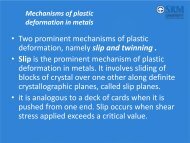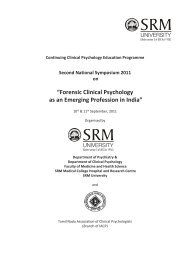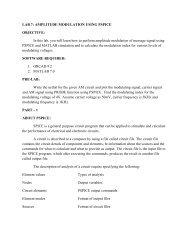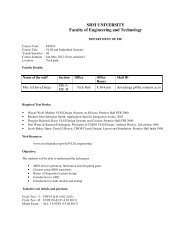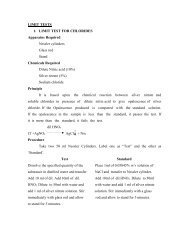UNIT 5 SYSTEM SECURITY
UNIT 5 SYSTEM SECURITY
UNIT 5 SYSTEM SECURITY
You also want an ePaper? Increase the reach of your titles
YUMPU automatically turns print PDFs into web optimized ePapers that Google loves.
<strong>UNIT</strong> 5 <strong>SYSTEM</strong> <strong>SECURITY</strong><br />
•Intruder –Intrusion detection system<br />
• Virus and related threats – Countermeasures<br />
• Firewalls design principles ‐Trusted systems<br />
•Practical implementation of cryptography<br />
and security<br />
Slides Courtesy of William Stallings, “Cryptography & Network Security”, Pearson Education, 4th Edition
Chapter‐1 Intruders<br />
• Intrusion detection system
Intruders<br />
• significant issue for networked systems is<br />
hostile or unwanted access<br />
• either via network or local<br />
• can identify classes of intruders:<br />
– masquerader<br />
– misfeasor<br />
– clandestine user<br />
• varying levels of competence
Intruders<br />
• clearly a growing publicized problem<br />
– from “Wily Hacker” in 1986/87<br />
– to clearly escalating CERT stats<br />
• may seem benign, but still cost resources<br />
• may use compromised system to launch other<br />
attacks<br />
• awareness of intruders has led to the<br />
development of CERTs
Intrusion Techniques<br />
• aim to gain access and/or increase privileges<br />
on a system<br />
• basic attack methodology<br />
– target acquisition and information gathering<br />
– initial access<br />
– privilege escalation<br />
– covering tracks<br />
• key goal often is to acquire passwords<br />
• so then exercise access rights of owner
Password Guessing<br />
• one of the most common attacks<br />
• attacker knows a login (from email/web page etc)<br />
• then attempts to guess password for it<br />
– defaults, short passwords, common word searches<br />
– user info (variations on names, birthday, phone, common<br />
words/interests)<br />
– exhaustively searching all possible passwords<br />
• check by login or against stolen password file<br />
• success depends on password chosen by user<br />
• surveys show many users choose poorly
Password Capture<br />
• another attack involves password capture<br />
– watching over shoulder as password is entered<br />
– using a trojan horse program to collect<br />
– monitoring an insecure network login<br />
• eg. telnet, FTP, web, email<br />
– extracting recorded info after successful login (web<br />
history/cache, last number dialed etc)<br />
• using valid login/password can impersonate user<br />
• users need to be educated to use suitable<br />
precautions/countermeasures
Intrusion Detection<br />
• inevitably will have security failures<br />
• so need also to detect intrusions so can<br />
– block if detected quickly<br />
– act as deterrent<br />
– collect info to improve security<br />
• assume intruder will behave differently to a<br />
legitimate user<br />
– but will have imperfect distinction between
Approaches to Intrusion<br />
Detection<br />
• statistical anomaly detection<br />
– threshold<br />
– profile based<br />
• rule‐based detection<br />
– anomaly<br />
– penetration identification
Audit Records<br />
• fundamental tool for intrusion detection<br />
• native audit records<br />
– part of all common multi‐user O/S<br />
– already present for use<br />
– may not have info wanted in desired form<br />
• detection‐specific audit records<br />
– created specifically to collect wanted info<br />
– at cost of additional overhead on system
Statistical Anomaly Detection<br />
• threshold detection<br />
– count occurrences of specific event over time<br />
– if exceed reasonable value assume intrusion<br />
– alone is a crude & ineffective detector<br />
• profile based<br />
– characterize past behavior of users<br />
– detect significant deviations from this<br />
– profile usually multi‐parameter
Audit Record Analysis<br />
• foundation of statistical approaches<br />
• analyze records to get metrics over time<br />
– counter, gauge, interval timer, resource use<br />
• use various tests on these to determine if<br />
current behavior is acceptable<br />
– mean & standard deviation, multivariate, markov<br />
process, time series, operational<br />
• key advantage is no prior knowledge used
Rule‐Based Intrusion Detection<br />
• observe events on system & apply rules to<br />
decide if activity is suspicious or not<br />
• rule‐based anomaly detection<br />
– analyze historical audit records to identify usage<br />
patterns & auto‐generate rules for them<br />
– then observe current behavior & match against<br />
rules to see if conforms<br />
– like statistical anomaly detection does not require<br />
prior knowledge of security flaws
Rule‐Based Intrusion Detection<br />
• rule‐based penetration identification<br />
– uses expert systems technology<br />
– with rules identifying known penetration,<br />
weakness patterns, or suspicious behavior<br />
– compare audit records or states against rules<br />
– rules usually machine & O/S specific<br />
– rules are generated by experts who interview &<br />
codify knowledge of security admins<br />
– quality depends on how well this is done
Base‐Rate Fallacy<br />
• practically an intrusion detection system<br />
needs to detect a substantial percentage of<br />
intrusions with few false alarms<br />
– if too few intrusions detected ‐> false security<br />
– if too many false alarms ‐> ignore / waste time<br />
• this is very hard to do<br />
• existing systems seem not to have a good<br />
record
Distributed Intrusion Detection<br />
• traditional focus is on single systems<br />
• but typically have networked systems<br />
• more effective defense has these working<br />
together to detect intrusions<br />
• issues<br />
– dealing with varying audit record formats<br />
– integrity & confidentiality of networked data<br />
– centralized or decentralized architecture
Distributed Intrusion<br />
Detection ‐ Architecture
Distributed Intrusion<br />
Detection –Agent<br />
Implementation
Honeypots<br />
• decoy systems to lure attackers<br />
– away from accessing critical systems<br />
– to collect information of their activities<br />
– to encourage attacker to stay on system so<br />
administrator can respond<br />
• are filled with fabricated information<br />
• instrumented to collect detailed information<br />
on attackers activities<br />
• single or multiple networked systems<br />
• cf IETF Intrusion Detection WG standards
Summary<br />
• have considered:<br />
– problem of intrusion<br />
– intrusion detection (statistical & rule‐based)<br />
– password management
Chapter‐2 Viruses and Other<br />
Malicious Content<br />
• Virus and related threats – Countermeasures
Viruses and Other<br />
Malicious Content<br />
• computer viruses have got a lot of publicity<br />
• one of a family of malicious software<br />
• effects usually obvious<br />
• have figured in news reports, fiction, movies<br />
(often exaggerated)<br />
• getting more attention than deserve<br />
• are a concern though
Malicious Software
Backdoor or Trapdoor<br />
• secret entry point into a program<br />
• allows those who know access bypassing usual<br />
security procedures<br />
• have been commonly used by developers<br />
• a threat when left in production programs<br />
allowing exploited by attackers<br />
• very hard to block in O/S<br />
• requires good s/w development & update
Logic Bomb<br />
• one of oldest types of malicious software<br />
• code embedded in legitimate program<br />
• activated when specified conditions met<br />
– eg presence/absence of some file<br />
– particular date/time<br />
– particular user<br />
• when triggered typically damage system<br />
– modify/delete files/disks, halt machine, etc
Trojan Horse<br />
• program with hidden side‐effects<br />
• which is usually superficially attractive<br />
– eg game, s/w upgrade etc<br />
• when run performs some additional tasks<br />
– allows attacker to indirectly gain access they do not have<br />
directly<br />
• often used to propagate a virus/worm or install a<br />
backdoor<br />
• or simply to destroy data
Zombie<br />
• program which secretly takes over another<br />
networked computer<br />
• then uses it to indirectly launch attacks<br />
• often used to launch distributed denial of<br />
service (DDoS) attacks<br />
• exploits known flaws in network systems
Viruses<br />
• a piece of self‐replicating code attached to<br />
some other code<br />
– cf biological virus<br />
• both propagates itself & carries a payload<br />
– carries code to make copies of itself<br />
– as well as code to perform some covert task
Virus Operation<br />
• virus phases:<br />
– dormant –waiting on trigger event<br />
– propagation – replicating to programs/disks<br />
– triggering –by event to execute payload<br />
– execution –of payload<br />
• details usually machine/OS specific<br />
– exploiting features/weaknesses
Virus Structure<br />
program V :=<br />
{goto main;<br />
1234567;<br />
subroutine infect‐executable := {loop:<br />
file := get‐random‐executable‐file;<br />
if (first‐line‐of‐file = 1234567) then goto loop<br />
else prepend V to file; }<br />
subroutine do‐damage := {whatever damage is to be done}<br />
subroutine trigger‐pulled := {return true if condition holds}<br />
main: main‐program := {infect‐executable;<br />
if trigger‐pulled then do‐damage;<br />
goto next;}<br />
next:<br />
}
Types of Viruses<br />
• can classify on basis of how they attack<br />
• parasitic virus<br />
• memory‐resident virus<br />
• boot sector virus<br />
• stealth<br />
• polymorphic virus<br />
• metamorphic virus
Macro Virus<br />
• macro code attached to some data file<br />
• interpreted by program using file<br />
– eg Word/Excel macros<br />
– esp. using auto command & command macros<br />
• code is now platform independent<br />
• is a major source of new viral infections<br />
• blur distinction between data and program files<br />
• classic trade‐off: "ease of use" vs "security”<br />
• have improving security in Word etc<br />
• are no longer dominant virus threat
Email Virus<br />
• spread using email with attachment<br />
containing a macro virus<br />
– cf Melissa<br />
• triggered when user opens attachment<br />
• or worse even when mail viewed by using<br />
scripting features in mail agent<br />
• hence propagate very quickly<br />
• usually targeted at Microsoft Outlook mail<br />
agent & Word/Excel documents<br />
• need better O/S & application security
Worms<br />
• replicating but not infecting program<br />
• typically spreads over a network<br />
– cf Morris Internet Worm in 1988<br />
– led to creation of CERTs<br />
• using users distributed privileges or by exploiting<br />
system vulnerabilities<br />
• widely used by hackers to create zombie PC's,<br />
subsequently used for further attacks, esp DoS<br />
• major issue is lack of security of permanently<br />
connected systems, esp PC's
Worm Operation<br />
• worm phases like those of viruses:<br />
– dormant<br />
– propagation<br />
• search for other systems to infect<br />
• establish connection to target remote system<br />
• replicate self onto remote system<br />
– triggering<br />
– execution
Morris Worm<br />
• best known classic worm<br />
• released by Robert Morris in 1988<br />
• targeted Unix systems<br />
• using several propagation techniques<br />
– simple password cracking of local pw file<br />
– exploit bug in finger daemon<br />
– exploit debug trapdoor in sendmail daemon<br />
• if any attack succeeds then replicated self
Recent Worm Attacks<br />
• new spate of attacks from mid‐2001<br />
• Code Red ‐ used MS IIS bug<br />
– probes random IPs for systems running IIS<br />
– had trigger time for denial‐of‐service attack<br />
– 2 nd wave infected 360000 servers in 14 hours<br />
• Code Red 2 ‐ installed backdoor<br />
• Nimda ‐ multiple infection mechanisms<br />
• SQL Slammer ‐ attacked MS SQL server<br />
• Sobig.f ‐ attacked open proxy servers<br />
• Mydoom ‐ mass email worm + backdoor
Worm Techology<br />
• multiplatform<br />
• multiexploit<br />
• ultrafast spreading<br />
• polymorphic<br />
• metamorphic<br />
• transport vehicles<br />
• zero‐day exploit
Virus Countermeasures<br />
• best countermeasure is prevention<br />
• but in general not possible<br />
• hence need to do one or more of:<br />
– detection ‐ of viruses in infected system<br />
– identification ‐ of specific infecting virus<br />
– removeal ‐ restoring system to clean state
Anti‐Virus Software<br />
• first‐generation<br />
– scanner uses virus signature to identify virus<br />
– or change in length of programs<br />
• second‐generation<br />
– uses heuristic rules to spot viral infection<br />
– or uses crypto hash of program to spot changes<br />
• third‐generation<br />
– memory‐resident programs identify virus by actions<br />
• fourth‐generation<br />
– packages with a variety of antivirus techniques<br />
– eg scanning & activity traps, access‐controls<br />
• arms race continues
Advanced Anti‐Virus<br />
Techniques<br />
• generic decryption<br />
– use CPU simulator to check program signature &<br />
behavior before actually running it<br />
• digital immune system (IBM)<br />
– general purpose emulation & virus detection<br />
– any virus entering org is captured, analyzed,<br />
detection/shielding created for it, removed
Digital Immune System
Behavior‐Blocking Software<br />
• integrated with host O/S<br />
• monitors program behavior in real‐time<br />
– eg file access, disk format, executable mods,<br />
system settings changes, network access<br />
• for possibly malicious actions<br />
– if detected can block, terminate, or seek ok<br />
• has advantage over scanners<br />
• but malicious code runs before detection
Distributed Denial of Service Attacks (DDoS)<br />
• Distributed Denial of Service (DDoS) attacks<br />
form a significant security threat<br />
• making networked systems unavailable<br />
• by flooding with useless traffic<br />
• using large numbers of “zombies”<br />
• growing sophistication of attacks<br />
• defense technologies struggling to cope
Distributed Denial of Service<br />
Attacks (DDoS)
Contructing the DDoS Attack Network<br />
• must infect large number of zombies<br />
• needs:<br />
1. software to implement the DDoS attack<br />
2. an unpatched vulnerability on many systems<br />
3. scanning strategy to find vulnerable systems<br />
– random, hit‐list, topological, local subnet
DDoS Countermeasures<br />
• three broad lines of defense:<br />
1. attack prevention & preemption (before)<br />
2. attack detection & filtering (during)<br />
3. attack source traceback & ident (after)<br />
• huge range of attack possibilities<br />
• hence evolving countermeasures
Summary<br />
• have considered:<br />
– various malicious programs<br />
– trapdoor, logic bomb, trojan horse, zombie<br />
– viruses<br />
– worms<br />
– countermeasures<br />
– distributed denial of service attacks
Chapter‐3 Firewalls
Introduction<br />
• seen evolution of information systems<br />
• now everyone want to be on the Internet<br />
• and to interconnect networks<br />
• has persistent security concerns<br />
– can’t easily secure every system in org<br />
• typically use a Firewall<br />
• to provide perimeter defence<br />
• as part of comprehensive security strategy
What is a Firewall?<br />
• a choke point of control and monitoring<br />
• interconnects networks with differing trust<br />
• imposes restrictions on network services<br />
– only authorized traffic is allowed<br />
• auditing and controlling access<br />
– can implement alarms for abnormal behavior<br />
• provide NAT & usage monitoring<br />
• implement VPNs using IPSec<br />
• must be immune to penetration
Firewall Limitations<br />
• cannot protect from attacks bypassing it<br />
– eg sneaker net, utility modems, trusted<br />
organisations, trusted services (eg SSL/SSH)<br />
• cannot protect against internal threats<br />
– eg disgruntled or colluding employees<br />
• cannot protect against transfer of all virus<br />
infected programs or files<br />
– because of huge range of O/S & file types
Firewalls –Packet Filters<br />
• simplest, fastest firewall component<br />
• foundation of any firewall system<br />
• examine each IP packet (no context) and<br />
permit or deny according to rules<br />
• hence restrict access to services (ports)<br />
• possible default policies<br />
– that not expressly permitted is prohibited<br />
– that not expressly prohibited is permitted
Firewalls –Packet Filters
Firewalls –Packet Filters
Attacks on Packet Filters<br />
• IP address spoofing<br />
– fake source address to be trusted<br />
– add filters on router to block<br />
• source routing attacks<br />
– attacker sets a route other than default<br />
– block source routed packets<br />
• tiny fragment attacks<br />
– split header info over several tiny packets<br />
– either discard or reassemble before check
Firewalls –Stateful<br />
Packet Filters<br />
• traditional packet filters do not examine<br />
higher layer context<br />
– ie matching return packets with outgoing flow<br />
• stateful packet filters address this need<br />
• they examine each IP packet in context<br />
– keep track of client‐server sessions<br />
– check each packet validly belongs to one<br />
• hence are better able to detect bogus packets<br />
out of context
Firewalls ‐ Application<br />
Level Gateway (or Proxy)<br />
• have application specific gateway / proxy<br />
• has full access to protocol<br />
– user requests service from proxy<br />
– proxy validates request as legal<br />
– then actions request and returns result to user<br />
– can log / audit traffic at application level<br />
• need separate proxies for each service<br />
– some services naturally support proxying<br />
– others are more problematic
Firewalls ‐ Application<br />
Level Gateway (or Proxy)
Firewalls ‐ Circuit Level<br />
Gateway<br />
• relays two TCP connections<br />
• imposes security by limiting which such<br />
connections are allowed<br />
• once created usually relays traffic without<br />
examining contents<br />
• typically used when trust internal users by<br />
allowing general outbound connections<br />
• SOCKS is commonly used
Firewalls ‐ Circuit Level<br />
Gateway
Bastion Host<br />
• highly secure host system<br />
• runs circuit / application level gateways<br />
• or provides externally accessible services<br />
• potentially exposed to "hostile" elements<br />
• hence is secured to withstand this<br />
– hardened O/S, essential services, extra auth<br />
– proxies small, secure, independent, non‐privileged<br />
• may support 2 or more net connections<br />
• may be trusted to enforce policy of trusted<br />
separation between these net connections
Firewall Configurations
Firewall Configurations
Firewall Configurations
Access Control<br />
• given system has identified a user<br />
• determine what resources they can access<br />
• general model is that of access matrix with<br />
– subject ‐ active entity (user, process)<br />
– object ‐ passive entity (file or resource)<br />
– access right –way object can be accessed<br />
• can decompose by<br />
– columns as access control lists<br />
– rows as capability tickets
Access Control Matrix
Trusted Computer Systems<br />
• information security is increasingly important<br />
• have varying degrees of sensitivity of information<br />
– cf military info classifications: confidential, secret etc<br />
• subjects (people or programs) have varying rights of<br />
access to objects (information)<br />
• known as multilevel security<br />
– subjects have maximum & current security level<br />
– objects have a fixed security level classification<br />
• want to consider ways of increasing confidence in<br />
systems to enforce these rights
Bell LaPadula (BLP) Model<br />
• one of the most famous security models<br />
• implemented as mandatory policies on system<br />
• has two key policies:<br />
• no read up (simple security property)<br />
– a subject can only read/write an object if the current<br />
security level of the subject dominates (>=) the<br />
classification of the object<br />
• no write down (*‐property)<br />
– a subject can only append/write to an object if the current<br />
security level of the subject is dominated by (
Reference Monitor
Evaluated Computer Systems<br />
• governments can evaluate IT systems<br />
• against a range of standards:<br />
– TCSEC, IPSEC and now Common Criteria<br />
• define a number of “levels” of evaluation with<br />
increasingly stringent checking<br />
• have published lists of evaluated products<br />
– though aimed at government/defense use<br />
– can be useful in industry also
Common Criteria<br />
• international initiative specifying security<br />
requirements & defining evaluation criteria<br />
• incorporates earlier standards<br />
– eg CSEC, ITSEC, CTCPEC (Canadian), Federal (US)<br />
• specifies standards for<br />
– evaluation criteria<br />
– methodology for application of criteria<br />
– administrative procedures for evaluation, certification<br />
and accreditation schemes
Common Criteria<br />
• defines set of security requirements<br />
• have a Target Of Evaluation (TOE)<br />
• requirements fall in two categories<br />
– functional<br />
– assurance<br />
• both organised in classes of families &<br />
components
Common Criteria Requirements<br />
• Functional Requirements<br />
– security audit, crypto support, communications,<br />
user data protection, identification &<br />
authentication, security management, privacy,<br />
protection of trusted security functions,<br />
resource utilization, TOE access, trusted path<br />
• Assurance Requirements<br />
– configuration management, delivery & operation,<br />
development, guidance documents, life cycle<br />
support, tests, vulnerability assessment, assurance<br />
maintenance
Common Criteria
Common Criteria
Summary<br />
• have considered:<br />
– firewalls<br />
– types of firewalls<br />
– configurations<br />
– access control<br />
– trusted systems<br />
– common criteria




